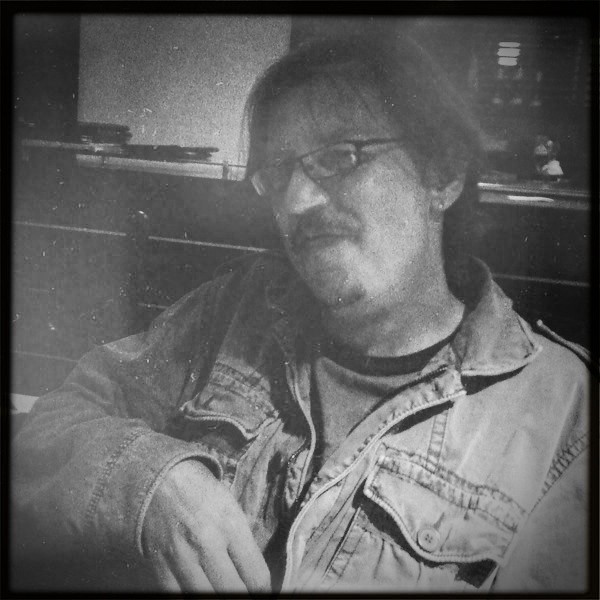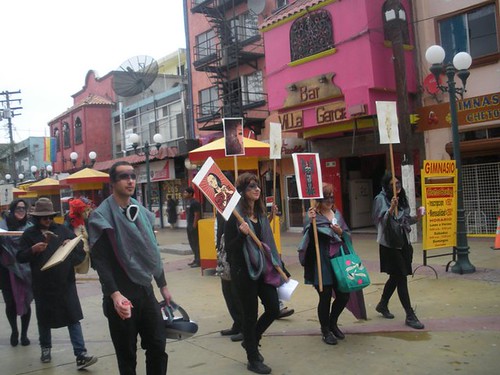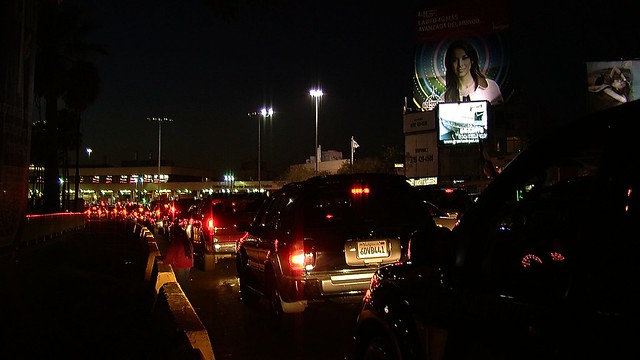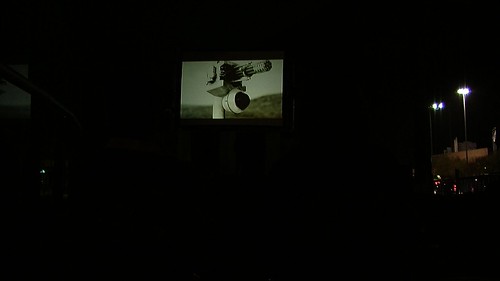[Vid: Kiosk dispensing sf minibuks to puzzled pedestrian border crossers.]
This past May Day weekend I had the good fortune to be a guest at one of the more interesting events I have ever attended: a science fictional convocation on the U.S.-Mexico border (like, so "on the border" the Homeland Security guys could watch our Power Point slides without the need to use the surveillance cameras looming over us). The event was "Lecturas de Cruce" (roughly, the "Crossing Lectures"), a four-day series of lectures, round tables, and performances endeavoring to illuminate the border region as a zone in which we can see and create the future. The lectures followed a two-month program of science fictional interventions, DESDE AQUI VE EL FUTURO (roughly, "from here you see the future"), in which students from the Autonomous University of Baja California under the tutelage of Professor (and science fiction writer) Pepe Rojo presented visions of the future to the travelers gathered at the border. The event was sponsored and programmed by the Tijuana Cultural Center (CECUT) under the direction and management of literary director Mara Maciel and her colleague Samantha Luna.

[Pic: Maestro Pepe Rojo, a little spent after the last evening of programming.]
The interventions included a talking dispensary of free science fiction books, a newspaper of the future handed out to the cars queued in the 90-minute line to cross, dance performances by pre-programmed cyborgs, future scenarios printed on bookmarks and handed out for consideration by the crowds, and even a procession of devotees of an imaginary saint, the cyborg Guadalupe known as Santa Ste.la, whose appearance with her acolytes passing through the center of Tijuana caused a near-riot, multiple anti-Satanic genuflections, and several calls for immediate baptisms.

[Pic: The procession of Sta.Ste.la.]
The idea of science fiction as the source of artistic interventions in real life is a brilliant and underused strategy. There are precedents—Ballard's 1960s crashed car installations, the recent post-apocalyptic reality show, and all our 20th century American Tomorrowlands—but no real direct analog (I can think of) for an event in which the imaginations of scores of local college students are harnessed to season the arteries of border commerce with visions of dozens of imminent futures. In the atemporal age of Network Culture ascendant, I expect and hope we will see more such speculative interventions in the present.

[Pic: Cyborg dancer points the way forward: through your head.]
The final event, the lecture program, was held in an abandoned government facility, a former Mexican passport office a couple of hundred yards from the U.S. border crossing. This is the chokepoint for the whole region, at which cars and pedestrian crossers converge to take their place in lines that can take hours, surrounded by dispensaries of prescriptionless pharmaceuticals (and soda bottles of pseudo-Viagra) and billboards advertising budget plastic surgery. During the program, stickers advised drivers to tune into the lectures on local simulcast as they sat in the adjacent lanes of crossing; they could even see the slides of the presenters as they approached. Overseeing it all was a giant Verizon billboard featuring an image that keynote presenter Bruce Sterling duly noted could have passed for an eyeball-kicking cyberpunk book cover in 1985, but is now taken for granted: a lovely woman surrounded in concentric colored halos of network radiance, begging Mexicans to plug into her 4G as fast as possible.

[Pic: A captive audience (programming underway to left of photo).]
In addition to Pepe and Bruce, participants included leading Mexican science fiction writers Bernardo Fernández (aka Bef), Gerardo Porcayo, Miguel Ángel Fernández, Gabriel Trujillo Muñoz, and children's author Francisco Hinojosa. Latin American sf scholar Professor Libby Ginway also attended and led most of the q&a. The program also included a screening of Alex Rivera's brilliant film Sleep Dealer, a cyberpunk tale of near-future Tijuana, and a performance of improvised techno by Casa Wagner (who also ended the program with a wild night of trance-inducing electrocumbia).

[Pic: Surveillance interrogation device presented by yours truly for the consideration of the captive audience.]
The border is a perfect place to go to envision futures. The border wall articulates an insanely dystopian present—a DMZ far more intimidating than the Berlin wall was for those of us saw it live and in the flesh complete with schefferhunds and land mines. Approaching Mexico from the US side, you are admonished with escalating warnings that you are, in essence, playing with your life by crossing over to Narcoland. For those of us who survived downtown Manhattan in the 70s and 80s, or DC in the early 90s, it's like back to the Escape From New York future. What you quickly realize after you have crossed over a few times is the extent to which the border is a permeable membrane designed to reinforce the fiction of political jurisdictional boundaries that Network Culture (including the culture of the most powerful network: Capital) is obliterating—and, as Berkeley's Wendy Brown suggests, the increasing effort to reinforce the border with physical and virtual fortifications is really just an effort by an increasingly irrelevant sovereign nation state to sustain the idea of its existence. Revealing an American future in which either the Nation State no longer exists in a form we recognize, or sustains the fiction of its 19th-20th century version through co-optation of a media-doped populace backed by a nascent Homeland Security sort of tyrannical force.
[Vid: Casa Wagner makes free jazz Tijuanense from the sonic materials of the border city.]
So while you think about what your own path would be to get Snake Plissken out of the cultural labyrinth, I would point you in the direction of Tijuana, where you can get some of the best Lacanian Cochinita Pibil around.

7 comments:
Do you think you could change the Flickr links so it's possible to find the actual photograph? Those weird farm6.static.flickr.com URLs make it impossible to recover the Flickr accession...
Chris, great post.
Happily, analogs and predecessors for projects such as this are plentiful, if disparate.
A few examples
- at an product/object level http://bit.ly/mRXZv4
- at a building level http://bit.ly/ic2ENc
- at a neighbourhood level http://bit.ly/aZjI8
- at a state level http://bit.ly/8X317v
- at a national level http://bit.ly/hoQe6c
Here's a swarm of students manifesting alternative futures on a university campus... http://bit.ly/2Z3tkH
...and perhaps my favourite example of all in this vein (along with the Tunisian one linked above) was by The Yes Men and Steve Lambert, aided by an army of volunteers in distributing a 'special edition' of the New York Times a few years ago. http://bit.ly/kq8TnK
That's some of the 'guerrilla futures' stuff.
Much more again appears in 'contained' settings such as futures workshops or consultants' output for clients (e.g. Jason Tester's work at Institute for the Future), games (e.g. a number of Jane McGonigal's projects), and galleries or museums (notably, material emanating from the Design Interactions dept at London's Royal College of Art, and also the recent exhibition 'Made Up' at the Art Center College of Design, Pasadena).
'Experiential futures' is an emerging practice at the intersection of foresight, design/media, and activism - a cousin to what our mutual friend Bruce Sterling calls 'design fiction'. As a practitioner and advocate of this kind of work, I find it really encouraging to see more examples - such as the Tijuana Liberation Front - cropping up!
Thanks again for posting.
stuart candy
@futuryst
Kieran -- You can find all those photos in a more user-friendly format at my Flickr page: http://www.flickr.com/photos/43518282@N00/sets/72157626531946569/. I will try to tweak the links later—thanks for the suggestion.
Stuart, thanks for those awesome links! I can't wait to check all of that (and your work) out.
Thanks--
Chris
I agree. Great post, Chris. Thanks a lot, I'm happy you had a great time, so did I. I'm still receiving info from a lot of students, and trying to process the whole stuff.
And Stuart, those links wil keep me busy the next weeks. Thanks. I had some references (like the Yes Men newspaper) and Bourriad's "relational aesthetics", and when we started the project we called it a collective imagination experiment, which worked out pretty well, as we showcased the work of more than 150 students.
I love the term "experiential futures", did you coin it? I will throw it left and right during the next months.
Comment status: Blogger completely crashed last week and the many comments on this post se fueron. Google/Blogger claims it is in the processing of restoring. This was a complete system failure apparently, but hopefully all will be back soon. Thanks!
Chris, good to see things back up and running.
T(e)M, yes, experiential futures was the topic of my doctorate, and the term seemed to meet my need of a medium-neutral descriptor for a diverse projects in which scenarios were made more vivid, tangible, etc.
Really interested to hear more about what you guys learned from this project on reflection...
Stuart — That Tunisian project you noted is fascinating. To what extent do you think the revolution itself (or others) were speculative projects of Network culture (social media etc.) made real? Perhaps that's not the case, but when you see the tactical role of social media in facilitating these popular overthrows (smart phones instead of AK-47s?), you can't help but wonder when that is going to happen: the Network incubates the entire revolution as a counter-vision for the society, then tries to make it real.
Chris
Post a Comment